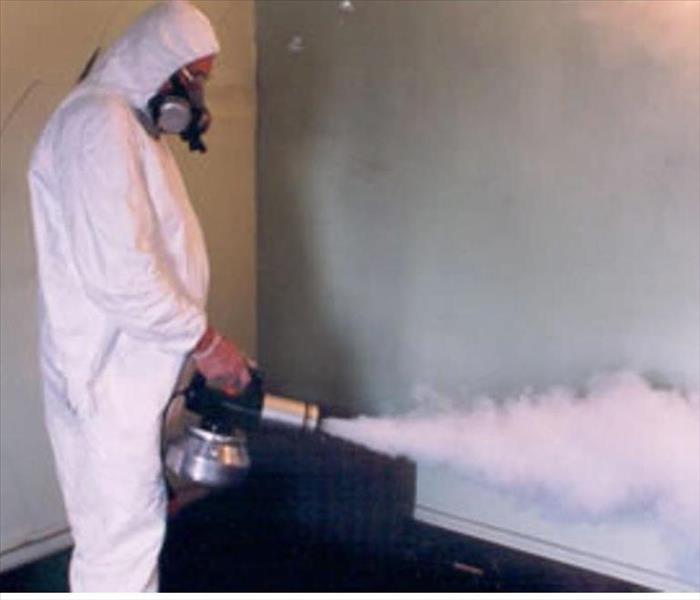Which Provides the Best Results—Sprayers, Foggers or Misters
12/1/2017 (Permalink)
Which Provides the Best Results—Sprayers, Foggers or Misters
A clear understanding of the advantages and disadvantages of each type of device will help the restorer decide which unit will provide the best results in a particular job site. SERVPRO of East Brownsville & South Padre Island is equipped with all of this equipment and knows the job will dictate which unit could yield the best results.
Equipment evaluation and usage
Four distinct methods of dispersing deodorizing treatments are utilized. These methods are defined chiefly by the size of water droplets produced:
- Pressure/compression sprayers
- Wet foggers/misters
- ULV (ultra-low volume) sprayers
- Thermal-fogging devices
Pressure/ compression sprayers
These comprise the largest class of odor control application equipment. There are three main types:
- Pump type
- Electric
- Airless paint sprayer
Pressure/ compression sprayers produce droplets that are often hundreds of microns in size. A micron is a unit of measure equal to one thousandth of a millimeter or 1/25,000th of an inch. These give the professional the greatest amount of control over where the spray is applied. They allow the professional to put a physical deposit of the proper deodorant where there was a physical deposit of odor thereby preventing further release of any odorous gases from the surface. Large droplets are an advantage when the desired outcome is to coat a surface.
Wet foggers/ misters
These constitute a large class of deodorant application tools. Misters work by mechanical action, using air pressure and specialized nozzles to break liquid into droplets.
Advantages
- Lower in cost than other types of fogging equipment.
- Droplets dispersed by these machines range in size from 25-100 microns.
Disadvantages
- Often lack precision metering.
- When machine operator is inexperienced, wetting, fallout and staining can occur to moisture sensitive surfaces.
- The droplet size is typically much larger than the size of odor molecules and, therefore, does not penetrate the same as other types of fogging equipment.
ULV foggers
These are wet foggers that produce smaller droplets than wet foggers/ misters.
Advantages
- ULVs are used to treat airspace with either water- or alcohol-based formulations. Alcohol-based formulations produce smaller sized droplets. ULVs can be adjusted to generate particles in the 8-15 micron size range.
- Droplets can stay suspended in air for five or six hours instead of a few minutes with a wet fogger/ mister, allowing for better penetration.
- Chance of over-wetting materials is greatly reduced when compared with wet (tri-jet) foggers.
- Good for application inside of forced-air ventilation systems and in crawl spaces.
Disadvantages
- Larger droplets generated by compression sprayers have a greater ability to coat surfaces than ULV generated droplets.
- Does not get small enough in droplet size to get the best penetration and permeation into cracks and crevices and, therefore, does not reproduce the penetration of the deodorant vapors.
Thermal fogging devices
Thermal foggers are machines that utilize heat to change liquids into small droplets. These droplets condense when introduced into a cooler atmosphere. Thermal foggers can produce droplets as small as 0.5 microns up to 2 microns in size. Petroleum-based formulations are normally used with thermal fogging devices.
Differences between thermal and ULV fogging
The principle difference between ULV and thermal fogging is the thermal generation process produces a smaller and more consistent droplet size. Thermal fogging produces a dry or damp fog as opposed to the wet ULV aerosol.
Although many thermal fogging devices are limited to applying only oil-based formulations, some thermal foggers are available that may also be utilized to apply water-based formulations.
- The concentration of active material in thermal fogging is usually lower than in ULV applications.
- Thermal fog droplets have better penetration and permeation properties than ULV droplets.
- Thermal fog lends itself to treatment of both large and small dwellings and buildings.
- Gas-powered thermal foggers require no electrical source; no need to delay treatment if power is not available.
- The small droplet size makes it possible to envelop contaminated atmospheres with odor counteractant, resulting in faster and more complete applications.
Gasoline-powered thermal fogger
Gasoline-powered thermal foggers do not require electricity and are capable of producing substantially smaller droplets than electrical powered units. They also produce larger volumes of fog.
Electric thermal fogger
Electric thermal foggers produce smaller volumes of fog with larger droplets. For simple, smaller jobs they are very useful. Be sure to use with a heavy-gauge extension cord and follow manufacturer’s directions for use.
All are effective tools in our Industry. But it is clear that training and knowledge of these units is vital for the success of the project. Deodorizing or disinfecting, SERVPRO of East Brownsville & South Padre Island has highly trained technicians skilled in the use of these pieces of equipment as well as the chemicals involved in their use.






 24/7 Emergency Service
24/7 Emergency Service
